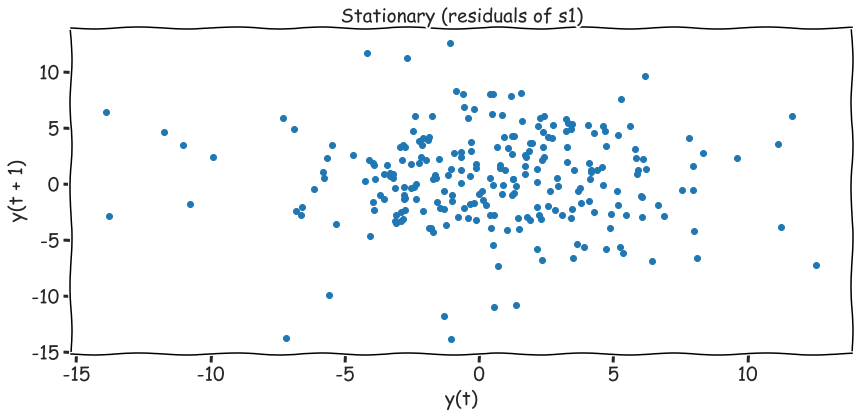Time Series Analysis
import pandas as pd
import numpy as np
import statsmodels as sm
import matplotlib.pyplot as plt
%matplotlib inline
from pylab import rcParams
import warnings
from random import shuffle
# wide figures
# warnings
warnings.filterwarnings("ignore")
large = 19
params = {
'axes.titlesize' : large,
'legend.fontsize' : large,
'figure.figsize' : (14,6),
'axes.labelsize' : large,
'axes.titlesize' : large,
'xtick.labelsize' : large,
'ytick.labelsize' : large,
'figure.titlesize' : large,
'lines.linewidth' : 3.0
}
plt.rcParams.update(params)
plt.style.use('seaborn-whitegrid')
_ = plt.xkcd()
df = pd.read_csv('data/AirPassengers.csv', index_col='date', parse_dates=True)
df.head(3)
| traffic | |
|---|---|
| date | |
| 1949-01-01 | 112 |
| 1949-02-01 | 118 |
| 1949-03-01 | 132 |
_ = df.plot(figsize=(14,6))

#Seasonal Decomposition
from statsmodels.tsa.seasonal import seasonal_decompose
results = seasonal_decompose(df.traffic, model="multiplocative")
_ = results.plot()
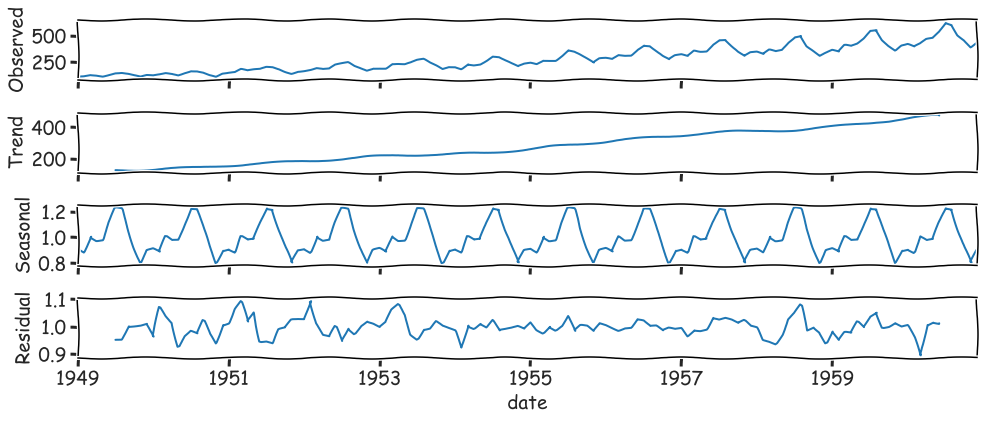
#Exponential Moving Average (Simple, Double and Triple)
ma = pd.DataFrame()
ma['Trafic'] = df.traffic
# ma['6m_SMA'] = ma['Trafic'].rolling(window=6).mean()
# ma['12m_SMA'] = ma['Trafic'].rolling(window=12).mean()
ma['12m_EMW'] = ma['Trafic'].ewm(span=12,adjust=False).mean()
_ = ma.plot()
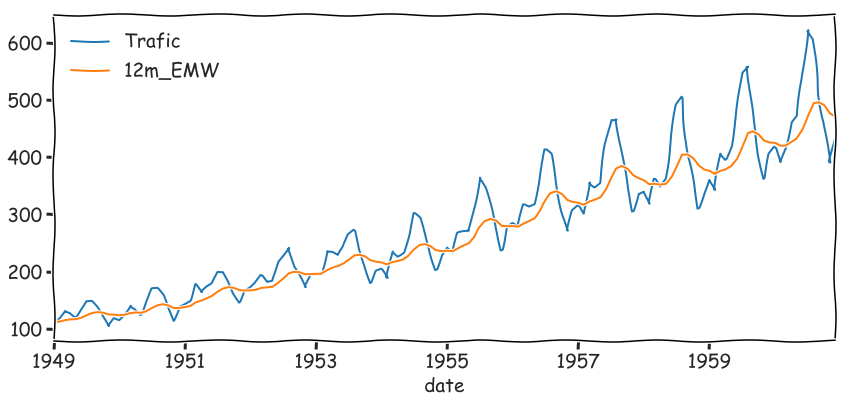
from statsmodels.tsa.holtwinters import SimpleExpSmoothing, ExponentialSmoothing
alpha = 2/(12+1)
ma = df.copy()
ma.index.freq = 'MS'
ma['EWMA12'] = df.traffic.ewm(alpha=alpha,adjust=False).mean()
# simple exponential smoothing.
ma['SES12'] = SimpleExpSmoothing(df.traffic) \
.fit(smoothing_level=alpha,optimized=False) \
.fittedvalues.shift(-1)
ma['DES12_add'] = ExponentialSmoothing(df.traffic, trend='add') \
.fit().fittedvalues.shift(-1)
ma['DES12_mul'] = ExponentialSmoothing(df.traffic, trend='mul') \
.fit().fittedvalues.shift(-1)
_ = ma.plot()

detailed view
ma.iloc[:24].plot(figsize=(14,3)).autoscale(axis='x',tight=True)

# Triple Exponential Smoothing
ma['TES_12_add'] = ExponentialSmoothing(ma.traffic, trend='add',seasonal='add',seasonal_periods=12) \
.fit().fittedvalues
ma['TES_12_mul'] = ExponentialSmoothing(ma.traffic, trend='mul',seasonal='mul',seasonal_periods=12) \
.fit().fittedvalues
_ = ma[['TES_12_add', 'TES_12_mul', 'DES12_add', 'DES12_mul']].plot()

Detailed view
part = ma[['TES_12_add', 'TES_12_mul', 'DES12_add', 'DES12_mul']].iloc[:24]
_ = part.plot(figsize=(14,6)).autoscale(axis='x',tight=True)
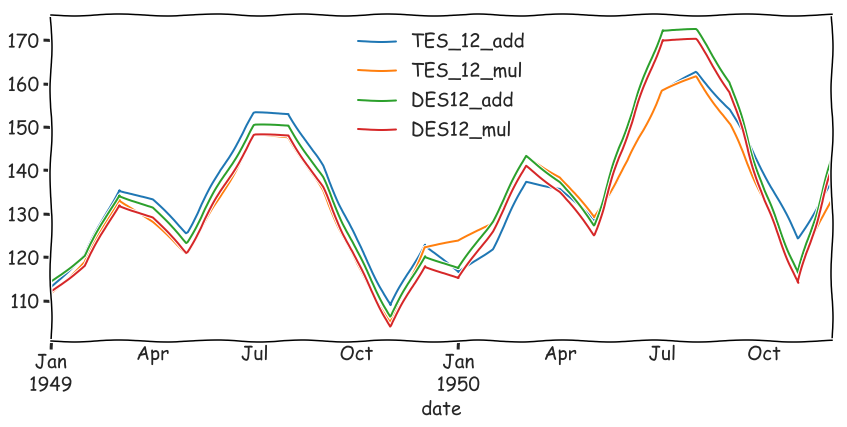
#Evaluating Predictions
- Mean Absolute Error
- Mean Squared Error
- Root Mean Square Error
$y$ - real data, $\hat{y}$ - prediction.
#MAE Mean Absolute Error
$\dfrac{1}{n} \sum\limits_{i=1}^n |y_i-\hat{y}_i|$
#MSE Mean Squared Error
$\dfrac{1}{n} \sum\limits_{i=1}^n (y_i-\hat{y}_i)^2$
#RMSE Root Mean Square Error
$\sqrt{\dfrac{1}{n} \sum\limits_{i=1}^n (y_i-\hat{y}_i)^2}$
from sklearn.metrics import mean_squared_error, mean_absolute_error
split = int(len(df.traffic)*.4)
train, test = df.traffic[:split], df.traffic[split:]
## Exponential Smoothing
model = ExponentialSmoothing(train, trend='mul', seasonal='mul', seasonal_periods=12).fit()
predictions = model.forecast(len(test)).rename('HW Forecast')
predictions.head(3)
result >>> 1953-10-01 216.577790
result >>> 1953-11-01 192.472637
result >>> 1953-12-01 221.219106
result >>> Freq: MS, Name: HW Forecast, dtype: float64
df.traffic[:len(test)].plot(legend=True,label='Train')
predictions.plot(legend=True,label='Prediction')
_ = test.plot(legend=True,label='Test')
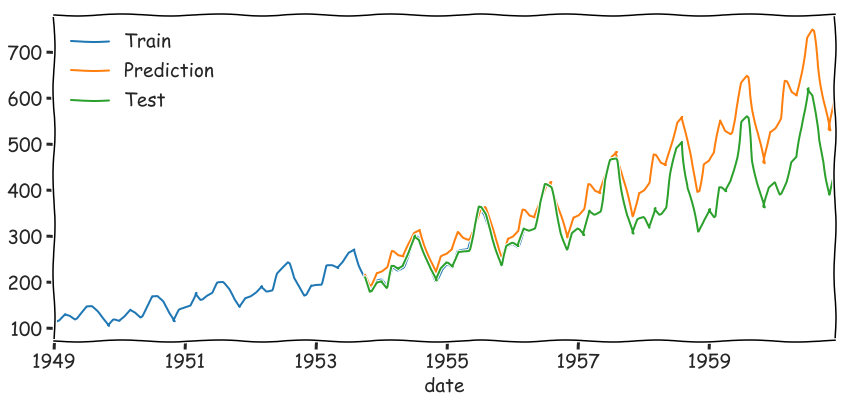
items = {
'MAE': mean_absolute_error(test, predictions),
'MSE': mean_squared_error(test, predictions),
'RMSE': mean_absolute_error(test, predictions)**.5,
}
for k, v in items.items(): print("{:<5}: {:<6.4f}".format(k,v))
> MAE : 62.5581
> MSE : 6510.0606
> RMSE : 7.9094
test.describe()
result >>> count 87.000000
result >>> mean 352.333333
result >>> std 97.477209
result >>> min 180.000000
result >>> 25% 277.500000
result >>> 50% 347.000000
result >>> 75% 410.000000
result >>> max 622.000000
result >>> Name: traffic, dtype: float64
#Stationary Data - no trends, no seasonality
Differencing Non-stationary data can be made to look stationary through differencing. A simple method called first order differencing calculates the difference between consecutive observations.
$y^{\prime}t = y_t - y{t-1}$
from statsmodels.tsa.statespace.tools import diff
dfs = pd.read_csv('data/2001rts1.txt', header=None, names=['s1'])
# First order Difference
# same as
# dfs['s2'] = dfs['s1'] - dfs['s1'].shift(1)
dfs['s2'] = diff(dfs['s1'], k_diff=1)
dfs.head(3)
| s1 | s2 | |
|---|---|---|
| 0 | 131.02 | NaN |
| 1 | 142.15 | 11.13 |
| 2 | 145.68 | 3.53 |
# no stationarity
_ = dfs['s2'].plot()
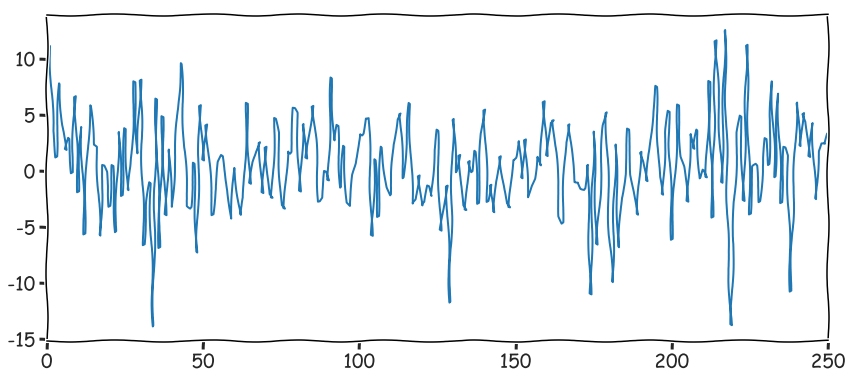
#ACF and PACF
from statsmodels.tsa.api import pacf as PACF
from statsmodels.tsa.api import acf as ACF
import statsmodels.graphics.tsaplots as tsaplots
def acf_pacf(y, extra=[], lags=None, figsize=(21,16), chart=None, title=None):
""" малює серію та графіки акф та чакф"""
fig = plt.figure(figsize=figsize)
layout = (2, 2)
ts_ax = plt.subplot2grid(layout, (0, 0), colspan=2, rowspan=1)
acf_ax = plt.subplot2grid(layout, (1, 0))
pacf_ax = plt.subplot2grid(layout, (1, 1))
if not title:
title = 'Time Series'
ts_ax.set_title(title)
ts_ax.plot(y, color="r")
y_avg = (y.max() - y.min()) / 10
y_s, y_e = 0 if y.min() - y_avg > 0 else y.min() - y_avg, y.max()+y_avg
ts_ax.set_ylim(y_s, y_e)
ts_ax.set_xlim(0, len(y))
# bgcm ykw
colors = list('bgcmk')
shuffle(colors)
for i in range(len(extra)):
ts_ax.plot(extra[i][0], color=colors[i], label=extra[i][1])
ts_ax.legend(loc="best")
_acf = ACF(y, nlags=lags)
_pacf = PACF(y, nlags=lags)
y_max = (_acf.max() if _acf.max() > _pacf.max() else _pacf.max()) + .1
y_min = (_acf.min() if _acf.min() < _pacf.min() else _pacf.min()) - .5
tsaplots.plot_acf(y, lags=lags, ax=acf_ax, alpha=0.05, title="Autocorelation")
acf_ax.set_ylim(y_min, y_max)
tsaplots.plot_pacf(y, lags=lags, ax=pacf_ax, alpha=0.05, title="Partial Autocorelations")
pacf_ax.set_ylim(y_min, y_max)
fig.tight_layout()
acf_pacf(dfs.s1, figsize=(12,10), lags=12)
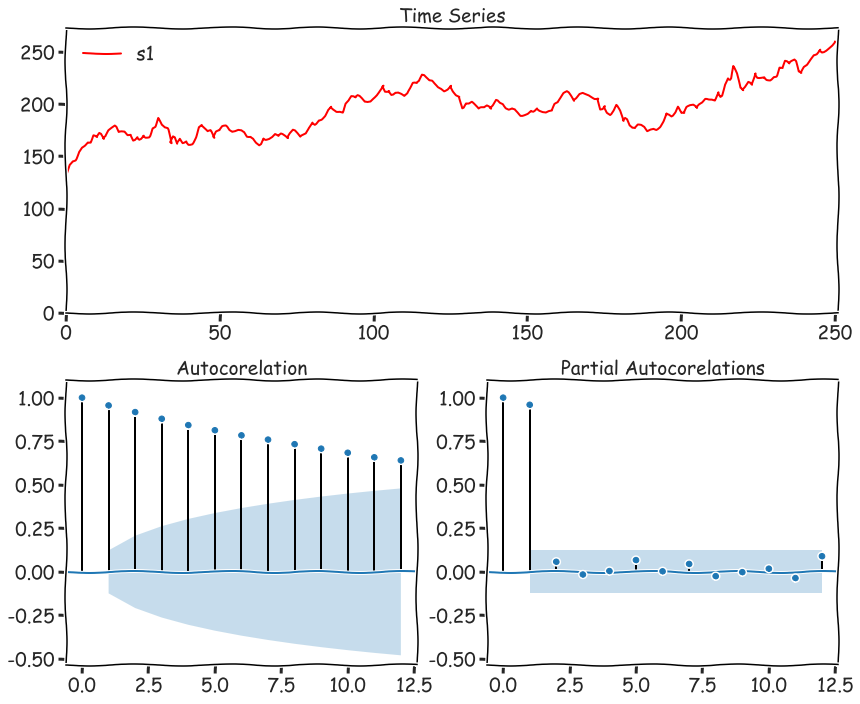
#ARIMA Model
We’ll investigate a variety of different forecasting models in upcoming sections, but they all stem from ARIMA.
ARIMA, or Autoregressive Integrated Moving Average is actually a combination of 3 models:
- AR(p) Autoregression - a regression model that utilizes the dependent relationship between a current observation and observations over a previous period
- I(d) Integration - uses differencing of observations (subtracting an observation from an observation at the previous time step) in order to make the time series stationary
- MA(q) Moving Average - a model that uses the dependency between an observation and a residual error from a moving average model applied to lagged observations.
- Moving Averages we’ve already seen with EWMA and the Holt-Winters Method.
- Integration will apply differencing to make a time series stationary, which ARIMA requires.
- Autoregression is explained in detail in the next section. Here we’re going to correlate a current time series with a lagged version of the same series. Once we understand the components, we’ll investigate how to best choose the $p$, $d$ and $q$ values required by the model.
#Lag Plot
ax = pd.plotting.lag_plot(df.traffic)
ax.set_title("Data With Trends - Non Stationary Data")
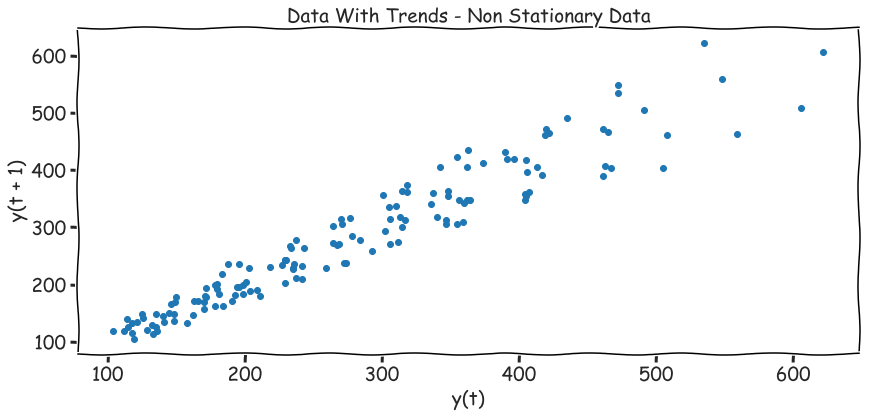
ax = pd.plotting.lag_plot(dfs.s2)
ax.set_title("Stationary (residuals of s1)")
